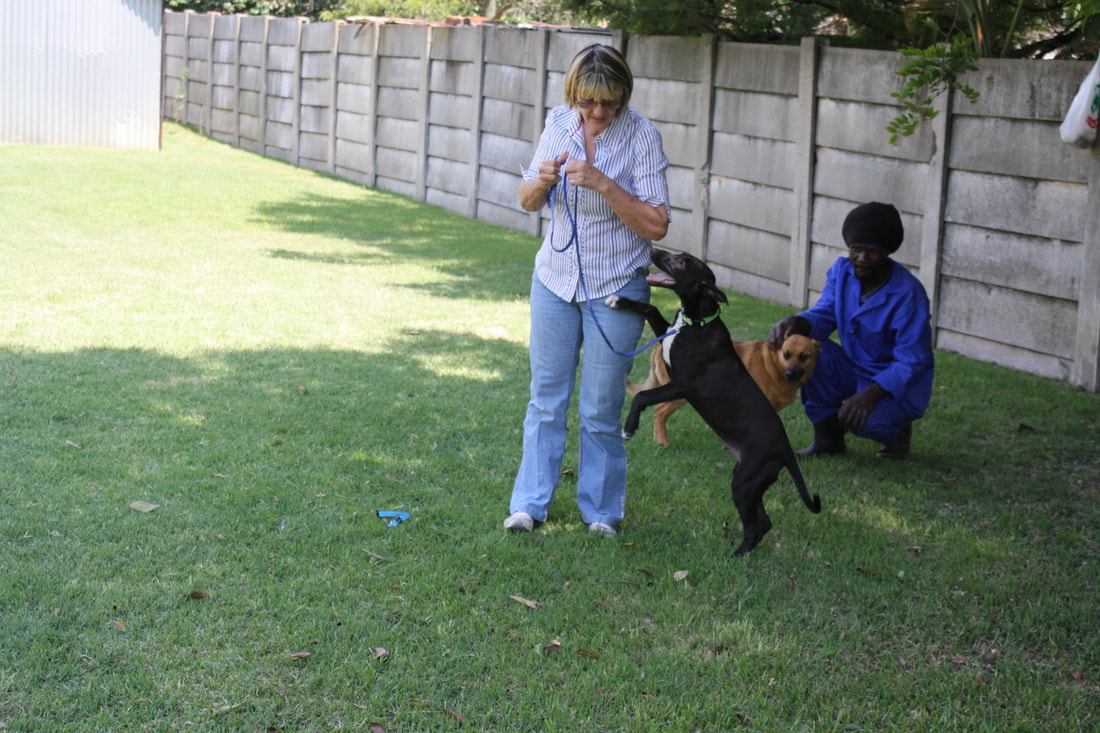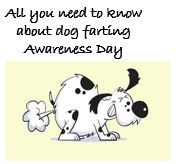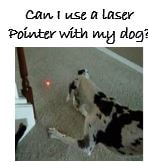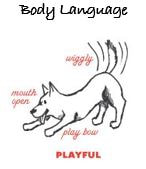One of the most common behaviours that we assist owner with, is when they have dogs that Jump Up against them.
It is well and fine if Fluffy jumps up against you when you arrive home, if you do not mind the behaviour, however if you are all dressed up in your going out togs, this exuberant greeting will not be welcome! Additionally, think of it from the point of view that you may not mind the behaviour, but if an elderly person, small children, or even somebody that was not comfortable around dogs, the behaviour of jumping up would not be appropriate! It is far better to train your dog not to jump up at all, and if you do enjoy the behaviour, then rather put it on cue once it has been extinguished.
An example of putting jumping up on cue - Scotty had a Border collie and his most favourite thing was to jump up to greet people, but not something she wanted to happ with visitor. She taught him an alternative manner of greeting people, and when this was in place, she then put his jumping up behaviour on cue - how? After being greeted politely at the door, she went with him to another area of the home, and gave the cue be bad!' On hearing this cue, Brady would jump around like the proverbial Jack in a Box, and then jump up into her arms. Manners of greeting people remained in place and Brady could still enjoy doing something he loved.
The most important aspects of changing this behaviour are; -
Here's How
When helping a client with changing this behaviour, there are other modifications that we bring in, however these below are some of the main modifications we suggest:
When arriving home
Work to Earn
Just as we have to work to earn our living, children have to work to pass at school etc, from now on your dog has to work - what does he have to do, go out to work? No!, all he now has to do is to Sit, for whatever he wants. Some examples of this:-
Work to Earn Specific
Here you are going to take the majority of the dog's food, and during the course of the day, call him, request a Sit, praise and then reward with a few pieces of his food. After doing this about 5 times in a row, add in a lovely treat to keep him motivated. If you feed raw, scoop out some from the frozen packet i small pieces and use these.
Practice this all over the home, and especially in the areas the dog used to jump up. Don't forget outside, we don't want the dog to only sit politely in selected areas - dog's do not generalise - just because they have learned not to jump up at the front door, does not mean that they will do it in other areas, in the garden and on walks! Even incorporate some Sit work when out for walks. Not only is this reinforcing the behaviour you do want, it helps to keep you and the dog 'connected'.
If you work during the day, then concentrate on this exercise over the weekend, and in the morning, give a portion of the daily ration in the dog's bowl, and do at least 5 minutes work before you give the food in the bowl. In the evening, you can use the whole meal's allowance to practice.
If you have a dog that is always ravenous, then give a portion of food in the bowl, before starting to feed by hand.
Please note that you request behaviour first, praise as the dog complies, then treat. We don't want a dog that only works for food, so the praise always comes first. With dogs that have tended to jump up, please award praise in a calm and quiet voice, and also showing the pleasure on your face - it you praise in an excited manner, there is the possibility that this will excite the dog, and it will revert to jumping up.
The Calling Game
Once your dog is starting to get the hang of this, then start having some fun. It has been shown in research, that when we are having fun while learning, not only do we humans tend to learn quicker, we also tend to retain the information learnt - this is exactly the same for dogs.
Fading
Although we will be rewarding the dog with treats while it is learning something new, what is vitally important is that praise is given first and is the most important aspect – then follow with the treat – we want to start to reduce the treat as soon as the dog fully understands the exercise. When your dog is complying 8 out of 10 times, then it is time to bring in Fading.
When you are teaching a dog a new behaviour you reward 100% of the time until the dog ‘get’s it’. You then immediately start to stagger the reward. When a reward is staggered, a dog will actually work harder for the reward, simply because it never knows when it will be forthcoming.
What Not to Do
It is well and fine if Fluffy jumps up against you when you arrive home, if you do not mind the behaviour, however if you are all dressed up in your going out togs, this exuberant greeting will not be welcome! Additionally, think of it from the point of view that you may not mind the behaviour, but if an elderly person, small children, or even somebody that was not comfortable around dogs, the behaviour of jumping up would not be appropriate! It is far better to train your dog not to jump up at all, and if you do enjoy the behaviour, then rather put it on cue once it has been extinguished.
An example of putting jumping up on cue - Scotty had a Border collie and his most favourite thing was to jump up to greet people, but not something she wanted to happ with visitor. She taught him an alternative manner of greeting people, and when this was in place, she then put his jumping up behaviour on cue - how? After being greeted politely at the door, she went with him to another area of the home, and gave the cue be bad!' On hearing this cue, Brady would jump around like the proverbial Jack in a Box, and then jump up into her arms. Manners of greeting people remained in place and Brady could still enjoy doing something he loved.
The most important aspects of changing this behaviour are; -
- Ignore the jumping up behaviour when it occurs. The more you shout and scream, you are inadvertently reinforcing the behaviour you don't want - attention is attention to a dog, whether negative or positive.
- Each and every member of the family has to ignore the jumping up and abide by the new method brought in - total consistency - if you are not consistent, this is like a child asking mom permission to do something and mom says no. Child then asks dad, and dad says yes (sound familiar!). What happens here, is not only are you totally confusing the dog, the behaviour you don't want if not only going to stay in place, it will tend to get worse
- Practice, practice, practice. Gary Player once said "the more I practice, the luckier I get'!
- The dog, is never, ever, allowed to jump up again, unless putting on cue once the dog has mastered the exercise, as mentioned below.
- Where children are concerned, they have the habit of lifting their hands when a dog jumps up, as in the picture above, and this actually encourages the dog to jump more. Rather work by yourself, then bring in other adult family members, and finally children, under strict supervision.
Here's How
When helping a client with changing this behaviour, there are other modifications that we bring in, however these below are some of the main modifications we suggest:
When arriving home
- When you arrive home, have some high value treats in your hand or pocket. As you enter the home/garden and first meet the dog - stand still, fold your arms, and avoid looking at the dog -ignore him completely. If the dog is constantly jumping up, still without looking at him, do what we call the 'doggy twist', and just move your body from side to side making it harder for him to jump up.
- The very second, the behaviour, request a Sit, praise quietly (you don't want to over excite him), and offer a treat - you are now praising and rewarding for the behaviour you do want and the dog will figure out what works and what does'nt and be more likely to comply. Then walk into the home as per normal.
- If your dog does not Sit on cue, then reward when the dog is standing quietly, and teach the dog how to Sit in-between.
- If you find that the second you take a step the dog starts jumping up again, then just repeat the sequence again - your dog will soon figure it out! Remember that when asking for the Sit, you use dog's name, the cue (with hand signal if you know it), praise and tra
- We are not telling our dogs we don't love them, rather we are putting in place basic manners. Interestingly enough, these tend to improve the bond between dog and owner and will impact positively where behaviour is concerned.
Work to Earn
Just as we have to work to earn our living, children have to work to pass at school etc, from now on your dog has to work - what does he have to do, go out to work? No!, all he now has to do is to Sit, for whatever he wants. Some examples of this:-
- Sit for attention
- Sit before being fed
- Sit before getting a treat
- Sit before ball being thrown
- Sit before going in, or out of a door
- Sit before getting into, or out of the car.
Work to Earn Specific
Here you are going to take the majority of the dog's food, and during the course of the day, call him, request a Sit, praise and then reward with a few pieces of his food. After doing this about 5 times in a row, add in a lovely treat to keep him motivated. If you feed raw, scoop out some from the frozen packet i small pieces and use these.
Practice this all over the home, and especially in the areas the dog used to jump up. Don't forget outside, we don't want the dog to only sit politely in selected areas - dog's do not generalise - just because they have learned not to jump up at the front door, does not mean that they will do it in other areas, in the garden and on walks! Even incorporate some Sit work when out for walks. Not only is this reinforcing the behaviour you do want, it helps to keep you and the dog 'connected'.
If you work during the day, then concentrate on this exercise over the weekend, and in the morning, give a portion of the daily ration in the dog's bowl, and do at least 5 minutes work before you give the food in the bowl. In the evening, you can use the whole meal's allowance to practice.
If you have a dog that is always ravenous, then give a portion of food in the bowl, before starting to feed by hand.
Please note that you request behaviour first, praise as the dog complies, then treat. We don't want a dog that only works for food, so the praise always comes first. With dogs that have tended to jump up, please award praise in a calm and quiet voice, and also showing the pleasure on your face - it you praise in an excited manner, there is the possibility that this will excite the dog, and it will revert to jumping up.
The Calling Game
Once your dog is starting to get the hang of this, then start having some fun. It has been shown in research, that when we are having fun while learning, not only do we humans tend to learn quicker, we also tend to retain the information learnt - this is exactly the same for dogs.
- Have two people a distance apart, and call the dog in an excited voice to you, so that he has to run. As he gets to the person, he is immediately asked to sit, is praised and a treat is given. Here you can even use part of the daily allowance of food. A fat dog is not a healthy dog!
- If there are more people in the family, then stand a good distance apart, and call the dog from person to person as above. Dog's love this game and at the same time, you
Fading
Although we will be rewarding the dog with treats while it is learning something new, what is vitally important is that praise is given first and is the most important aspect – then follow with the treat – we want to start to reduce the treat as soon as the dog fully understands the exercise. When your dog is complying 8 out of 10 times, then it is time to bring in Fading.
When you are teaching a dog a new behaviour you reward 100% of the time until the dog ‘get’s it’. You then immediately start to stagger the reward. When a reward is staggered, a dog will actually work harder for the reward, simply because it never knows when it will be forthcoming.
- You will call the dog, ask for a Sit and reward with praise and a treat. Now take a few steps away and again call your dog and request another Sit –Praise only. Now take another few steps and repeat with only the Praise again. The next step will be calling the dog and then Praising and Treating. Mix these up and sometimes 5 or 6 steps and then praise and reward and other times perhaps reward twice in a row – the dog does not know what to expect and works harder.
- Remember to practise in different locations. You may have a dog that sits perfectly every time you ask in the house, but does that dog do the same in the garden or on a walk?
- This method can also be used in more advanced training where the dog will only be rewarded for ‘the fastest, the best, and the closest’ etc.
- This method can be used for other behaviours you are teaching as well, remembering that Fading is only brought in when dog fully understands the exercise.
What Not to Do
- Never turn away from the dog or turn your back to it. This is more likely to cause the dog to jump up, and a dog jumping up on your back can be downright dangerous.
- Never knee a dog in the chest, which was an old fashioned method of training before we learnt the benefits of the positive reinforcement methods. Kneeing a dog in the chest not only causes pain and is abusive, plus the dog is more likely to start to jump up on the owner from behind. Kneeing in the chest can also cause aggressive behaviour from some dogs - think about it, how would you enjoy it!
- Never shout, scream or smack a dog for jumping up. As above, this will cause the behaviour to escalate, and physical punishment can cause aggression, cause fear and overall, damage the human canine bond.
|
Not only is this article amusing and so true - scientific research was also done on this topic!
|
Although this may seem a great game to do with a dog, it can have serious reprecussions!
|
Dr. Dunbar gives you some excellent insight into a dog's body language which all owners should have a basic understanding of.
|






